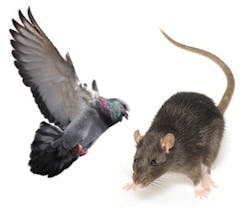Spring is when critters come out of a winter hiatus in search of three things: shelter, food and reproduction. Facility managers should be watchful as the seasons change for signs of pest problems. You can head off an infestation by springing into action with these overlooked pest management tips.
SEE ALSO:
A Natural Nuisance
Warmer temperatures and longer daylight are a signal to most pests that the threat of winter has abated. It’s likely that your building has already been home to pests seeking shelter from the elements. Common invaders seen in the spring include:
- Wasps and bees
- Ants
- Mosquitos
- Lady beetles
- Termites
- Spiders
While insects don’t hibernate the way that some mammals do, many enter a dormant state, explains Doug Webb, Manager of technical services with Terminix. When temperatures are more pleasant, they start to rebuild their numbers. Termites, for example, are notorious for swarming during the months of March to May as they head to a new colony.
Spring will also produce an uptick in ant activity, says Chad Gore, entomologist and market technical director with Rentokil North America. Their colonies enter a growth mode where they forage for food, attend to their egg-laying queen and provide resources for the whole army.
Lady beetles, the odorous biting cousin to ladybugs, are also likely to overwinter in straw or mulch beds or attic spaces, Webb notes. If they’re inside your building, they will swarm out through small cracks and openings in the spring.
While mosquitos are associated with summer, they emerge from hibernation and begin to lay eggs once temperatures are consistently above 50 degrees Fahrenheit at night, Webb explains.
Signs of Infestation or Colony Activity
As you tackle your spring cleaning list, pair preventive pest control measures with inspections. Most pests can be spotted with the naked eye – a trail of ants or termite wings are an obvious red flag – but your building and grounds can have many overlooked spots.
When you clean out docks, backrooms or storage areas, look for mice or rat droppings, recommends Webb. These spaces might not have been monitored well during the winter if they aren’t climate controlled. Remove general clutter so it doesn’t provide nooks and crannies for pests.
"Pair preventive pest control measures with inspections"
Inspect all weather stripping and caulking for sources of air and water leaks, Webb adds. Envelope gaps not only create thermal transfer but also let in sources of moisture that pests need for survival. This also applies to the foundation and roof, which may have snow or ice damage.
Review the condition of dumpsters, which offer an enticing buffet of food for many pests, Gore notes. Repair any metal trash bins with rusted holes. All outdoor waste containers should be located several feet from the perimeter so they don’t create a highway into your building.
Warehouse spaces should consider investing in screens for their dock doors to deter flying insects. Even if the insects don’t bother people, they can be a food source for spiders, which in turn attracts birds, says Webb.
Landscape Maintenance as Pest Control
Though spring is a natural opportunity to refresh your landscape, make sure that your plants aren’t inadvertently encouraging insects and animals to make a home. Decrease chances of pest problems by taking care of these issues:
- Trees and shrubs: Trim back so they don’t touch the building. If branches and limbs drape over the roof or brush against the facade, they create a natural bridge for pests, says Gore.
- Mulch: Only use sparsely. The purpose of mulch is to retain soil moisture, but it can also provide a water source for pests. Avoid continually adding layers of mulch – when it’s several inches thick, it creates protection from the summer heat, says Webb. Stone is a better alternative because it will still retain soil moisture but is less hospitable to pests, adds Gore.
- Flowering plants: Avoid planting ornamentals near the perimeter, under windows and next to entrances because those plants attract stinging pollinators, Gore recommends. Honeydew-producing insects also feed off of sap excreted by common flowers such as peonies, roses and clematis.
- Watering habits: It’s tempting to drench newly planted landscaping, but overwatering creates standing puddles of moisture that pests use for hydration and egg laying, Webb cautions.
A Fresh Look
Spring is an excellent occasion to renew your relationship with your pest control services provider, advise both Gore and Webb. It can be beneficial to have him or her inspect your property with a fresh set of eyes to spot problems that might have been overlooked.
Jennie Morton is a contributing editor for BUILDINGS.
About the Author
Jennie Morton
A former BUILDINGS editor, Jennie Morton is a freelance writer specializing in commercial architecture, IoT and proptech.
